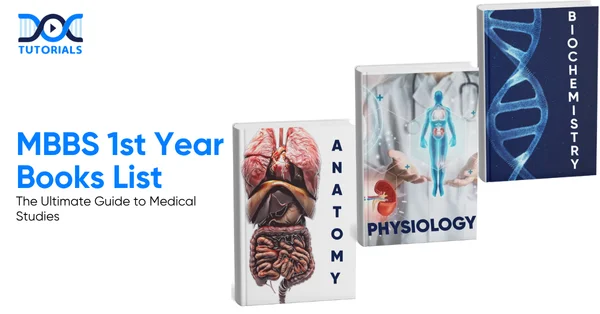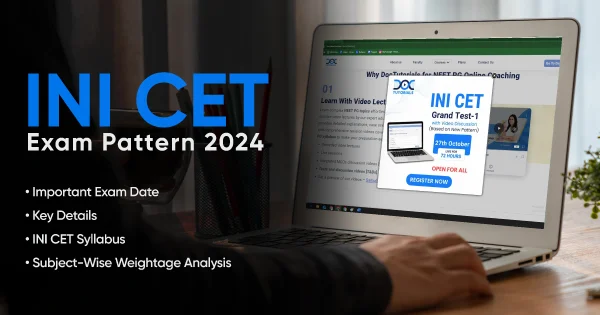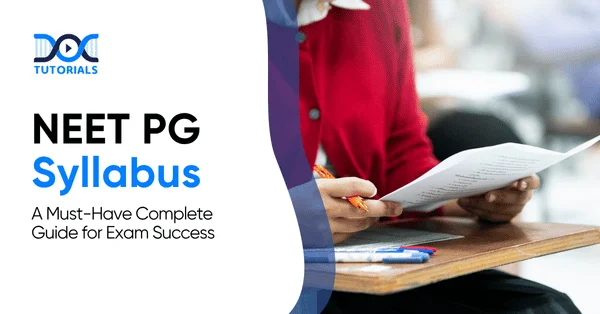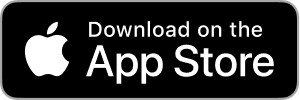MBBS 1st Year Books List: The Ultimate Guide to Medical Studies

Bachelor of Medicine, Bachelor of Surgery (MBBS) is a demanding four and a half years undergraduate degree in medicine with one year rotational internship as a compulsory requirement.
MBBS has 19 subjects, the first one being the cornerstone of a successful career in medicine. The 3 cornerstone subjects of the first year include Anatomy, Physiology, and Biochemistry, all of which are necessary to learn about the human body and physiology.
Thus, the MBBS first year book list should be comprehensive, simple to comprehend and strictly connected with the syllabus that your medical institution/university prescribes. In this guide, we will take you through the essential MBBS 1st year books and subject-wise suggestions for a solid medical foundation.
So, let’s begin!
MBBS 1st Year Subjects
In the first year of MBBS, the students usually study 3 fundamental subjects:
- Anatomy
- Physiology
- Biochemistry
Every one of these subjects requires a distinct set of reference books. MBBS 1st year recommended books must be complete, easy to understand, and closely related to the syllabus your medical college or university prescribes.
Choosing the right sources becomes vital in establishing a proper foundation in medical education.
Selecting the Right Books for MBBS 1st Year
Choosing the first year mbbs books list is essential for creating a strong base of medical science. Comprehensive textbooks enable students to grasp complex concepts easily, memorise important facts by heart, and apply them appropriately in real situations.
The list of MBBS books for 1st year below is a handpicked selection that has always been suggested and relied upon by MBBS students.
Best Books of Anatomy for MBBS Students
| Subject | Book Title | Author(s) | Description |
| Anatomy | Self-Assessment and Review of Anatomy | Rajesh K Kaushal | – It is written in easy-to-understand language, simple and clear with labelled diagrams, tables, and flowcharts. – 11 chapters about general anatomy, embryology, histology, neuroanatomy, head and neck, back, thorax, upper limb, abdomen, pelvis, and lower limb. – Conceptual clarity in all the topics, and focuses on clinical use. |
| Anatomy | New Across: A Complete Review of Short Subjects | Saumya Shukla, Siddharth Dixit, Anurag Shukla & Khushi Shukla | – One of the best-selling MCQ books focusing on short subjects. – Theory and MCQs with brief notes are provided for every topic for quick learning. – Tables, figures, flowcharts, and mnemonics to assist in memorising and learning effectively are included. – It is highly recommended as a bestseller for NEET-PG preparation. |
| Anatomy | Human Anatomy | BD Chaurasia, Krishna Garg | – Follows the CBME curriculum and incorporates the latest updates and advancements. – Features hand-drawn line diagrams by Dr. BD Chaurasia with colour coding. – FAQs and MCQs are presented in a “clinical mode.” – Provides Early Clinical Exposure (ECE) with case-specific signs, symptoms, investigations, and treatment. – Includes viva voce questions, molecular regulation, clinic-anatomical problems, and step-by-step dissection guidance. |
| Anatomy | Grey’s Anatomy for Students | Raveendranath Veeramani, Sunil Jonathan Holla, Parkash Chand & Sunil Chumber | – Considered the gold standard book for anatomy. – Updated edition includes set introductions, chapter summaries, and flowcharts to facilitate learning. – Levels I, II, and III classify structures in dissection into “must know,” “desirable to know,” and “good to know.” – Incorporates new modes of imaging and puts more focus on dissection. – A greater number of figure references promotes visual learning and useful review resources at the start of every chapter. – Cranial nerves are discussed in greater detail and provided with examples and flowcharts. |
| Anatomy | Cunningham’s Manual of Practical Anatomy | Rachel Koshi | – Ideal practical anatomy book for undergraduate students with simple, clear language. – Learning objectives are provided at the beginning of each dissection, and lab work is simple to follow with step-by-step instructions.- Colourful updated artwork improves comprehension. – Clinical application boxes and radiological images provide the connection between anatomy and medical practice. |
Best Books of Biochemistry for MBBS Students
| Subject | Book Title | Author(s) | Description |
| Biochemistry | Self-Assessment and Review of Biochemistry | Rebecca James Perumcheril | – Offers a complete concept-based biochemistry course with revised references, picture-based concepts, high-yield points, and full tables that are perfect for learning and revision. – Highly recommended for competitive entrance exams due to the inclusion of previous years’ questions and practice exercises. – Chapter matter is sourced from renowned books such as Harper’s 31st ed, Lehninger’s 7th ed, and Robbin’s 9th ed, clinically related to Harrison’s 20th ed, Nelson’s 20th ed, and CMDT 2019. |
| Biochemistry | Textbook of Biochemistry for Medical Students | DM Vasudevan, Sreekumari S & Kannan Vaidyanathan | – An MBBS student’s standard reference book, approved by the MCI and commonly used in medical colleges. – Includes clinical case studies in almost all chapters to enable the students to see the clinical and practical application of biochemical principles. – Contains 50 chapters divided into 6 structured parts, with each chapter concluding with essay questions, quick notes, multiple-choice questions, and viva-voce style exercises. – Has almost 1,000 figures, 200 tables, and 200 information boxes, which facilitate better understanding and usability for the students. |
| Biochemistry | Biochemistry | U. Satyanarayana & U. Chakrapani | – Offers a structured approach with self-assessment exercises, origins of important biochemical terms, case studies with biochemical correlations, and reference biochemical values. – Discusses basic principles such as Bioorganic and Biophysical Chemistry, biochemistry Tools, Immunology, Genetics and Clinical Biochemistry Lab principles. – The focus on connecting theory and clinical practice serves as a guarantee of the improved comprehension of practice on the actual ground. |
| Biochemistry | Lippincott Illustrated Reviews: Biochemistry (South Asian Edition) | Denise R. Ferrier; SAE Editors: Ritu Singh, Rajeev Goyal | – Demonstrates the relationship of biochemistry to routine medical practice through interdisciplinary, chapter-based case studies. – Structured in a clear outline format with full-colour illustrations and bullet points to simplify the complicated topics and to facilitate faster revision. – Includes a larger chapter on macronutrients and micronutrients to gain a thorough insight into nutritional biochemistry. – A special chapter on blood clotting has been included, with an in-depth description of the coagulation mechanisms and clinical importance. |
| Biochemistry | Harper’s Illustrated Biochemistry | Kathleen Botham, Peter J. Kennelly, Owen McGuinness, P. Anthony Weil, Peter Kennelly, Victor Rodwell | – Covers a wide range of advanced and clinically relevant topics, including extraterrestrial biomolecules, computer-aided drug design, and the effects of antioxidants on .apoptosis and cancer risk. – Emphasises clinical relevance through case studies, “Objectives” .boxes at the start of each chapter, review questions for every section, and tables summarising essential data. – Contains over 600 full-colour illustrations to aid comprehension and retention. – Each chapter includes a dedicated section on the biomedical value of the topic, bridging basic biochemical knowledge with practical medical applications. |
Best Books of Physiology for MBBS Students
| Subject | Book Title | Author(s) | Description |
| Physiology | Principles of Physiology | Debasis Pramanik | – The best thing about the book is that it employs colored boxes to point out complex physiological concepts. – The book consists of twelve chapters, with chapter one being an introduction to general physiology. – Haematology-related topics are thoroughly discussed in the third section, while the circulatory, digestive, and excretory systems are explained in detail in the fifth, sixth, and seventh sections, respectively. – The neurological, endocrine, and reproductive systems are extensively described in the ninth, tenth, and eleventh sections, respectively. |
| Physiology | Review of Physiology | Soumen Manna | – The book is organised into eight divisions, encompassing 19 chapters structured around various organ systems. – Topics include general physiology, nerve-muscle physiology, cardiovascular and respiratory systems, central nervous system, renal and gastrointestinal systems, and endocrine and reproductive systems. – Each chapter has multiple-choice questions (MCQs) with clear, brief, and precise explanations, supported by references to standard or research articles. – A newly added chapter titled “Male and Female Reproductive Physiology” is included in this edition. |
| Physiology | Crisp Complete Review of Integrated Systems Physiology | S Krishna Kumar | – Provides clear and straightforward explanations of physiological concepts. – Features analyses of ECG-related questions, acid-base disorder questions, calculations related to respiratory physiology, and image-based questions. |
| Physiology | Guyton and Hall Textbook of Medical Physiology (South East Edition) | John E. Hall, Michael E. Hall; Adaptation Editors: Mario Vaz, Anura Kurpad, Tony Raj | – Offers broader clinical coverage of degenerative diseases, including obesity, metabolic disorders, cardiovascular disorders, and Alzheimer’s disease. – Contains over 1,000 meticulously designed illustrations and sketches for enhanced learning. – Provides a clinically oriented perspective, linking basic physiology and pathology while emphasising essential cellular and molecular mechanisms in clinical medicine. – Updated with the latest research and aligned with the Guyton and Hall Textbook of Physiology, 14th edition. – All information is revised to correspond with the new MCI curriculum. |
| Physiology | Textbook of Physiology | A.K. Jain | – Includes over 700 figures, 2,000 multiple-choice questions, and more than 1,000 study questions. – Numerous clinical images are incorporated to facilitate understanding of clinical topics. – Study questions in each chapter are updated in accordance with Medical Council of India (MCI) standards. – Volume I covers general physiology, blood, nerve and muscle physiology, digestive, cardiovascular, respiratory, and excretory systems. – Volume II covers the nervous system, reproductive system, endocrine system, metabolism, nutrition, and special senses. – The South Asian Edition features include having a significant amount of content revision, a more detailed section on micronutrients and a thorough discussion of blood coagulation. |
While textbooks are the basis of every MBBS student’s knowledge, supplementing them with electronic material can help a lot in improving understanding and memory.
FAQs about MBBS 1st Year Books List
- Which book of Anatomy is the best one in the MBBS 1st year?
Human Anatomy by Dr. B.D. Chaurasia would be a great choice due to its detailed descriptions and high-quality illustrations. Other than that, “Grey’s Anatomy” is a world-famous reference book, renowned for its penetrating explanations and great clinical correlations.
- Which is the best MBBS 1st year physiology book?
Human Physiology of Guyton and Hall is familiar as the most complete and well-written book with an easy-to-read text. For those who want a concise text, “Essentials of Medical Physiology” by K. Sembulingam can also be used.
- Which Biochemistry books can be used for the MBBS 1st Year?
“Textbook of Biochemistry” by U. Satyanarayana has elaborate descriptions with clinical significance, whereas “Lippincott’s Biochemistry” is preferred due to its crisp figures and straightforward explanation of biochemical pathways.
- Which is the most difficult topic in MBBS?
The most difficult subject in MBBS is anatomy, which has been an esteemed core foundation subject in the study of medicine.
- How much do the must-have MBBS 1st-year books cost?
The MBBS 1st year books price list ranges from ₹500 to ₹5,000 per book, or ₹15,000 to ₹35,000 for the entire set, depending on the edition, publisher, and book. One must select the right books to establish a strong foundation of the main subjects such as Anatomy, Physiology and Biochemistry.
Conclusion
Choosing quality MBBS 1st-year books is an achievement for any medical student looking to establish a strong foundation of knowledge in Anatomy, Physiology, and Biochemistry. Knowing your curriculum, selecting good textbooks, and complementing them with online content will enable you to grasp complex concepts and progress in your medical career.
It’s not just about owning these books but about actively reading, practising MCQs, regularly revising, and using knowledge clinically that will determine your success. Keep updated with new editions, investigate other study aids, and plan your learning to stay ahead of the game.
With DocTutorials, you have access to mentorship learning, expert guidance, and personal counselling, along with the essential MBBS 1st-year textbooks. Join DocTutorials today and explore our MBBS course for enhancing your MBBS preparation!
Latest Blogs
-

INI CET Exam Pattern 2025: A Complete Guide with Subject-Wise Weightage
The Institute of National Importance Combined Entrance Test (INI CET) is your key to entering some of the most prestigious…
-

NEET PG Registration 2025: An Essential Guide For Exam Prep
The NEET PG registration, which is conducted online, is a crucial step in the exam process. Filling out the NEET…
-

NEET PG Syllabus 2026: A Must-Have Complete Guide for Exam Success
The NEET PG Syllabus acts as one of the foundation stones for aspiring postgraduate medical students like you who are…




